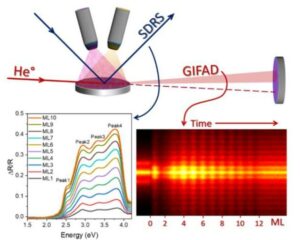Soutenance de thèse de Christian Perest SONNY TSOTEZEM
Growth by Molecular Beam Epitaxy and Real-time Multitechnique Characterization of Ultrathin Layers of PbI2 and MAPbI3
Christian Perest SONNY TSOTEZEM
ISMO
Two-dimensional (2D) van der Waals heterostructures have emerged as promising systems for next-generation optoelectronic applications due to their tunable interfacial properties. Among them, lead iodide (PbI₂) plays a crucial role as the precursor to methylammonium lead iodide (MAPbI3) perovskites. While van der Waals interactions are typically considered weak and non-disruptive, recent studies have revealed surprisingly strong interlayer coupling in 2D heterostructures. For instance, epitaxial growth of MoS₂ and MoSe₂ on graphene has shown significant shifts in vibrational modes and energy band alignment, indicating strong interfacial interactions. Similarly, PbI₂ nanodisks has demonstrated to exhibit strong epitaxial alignment on graphene despite notable lattice mismatches of -7.2%. The first objective of this thesis is to investigate, in real time, the structural and optical properties of PbI₂ monolayers deposited on graphene by molecular beam epitaxy (MBE). This includes understanding the growth mode, interfacial interactions, and their impact on the physical properties of the resulting heterostructure.
The second part of this work focuses on the fabrication of high-quality ultrathin MAPbI3 films using MBE. Spin coating remains the most common method for producing MAPbI3 because of its simplicity. However, it bears issues such as non-uniformity, limited control over the film morphology and crystallinity, along with the use of toxic solvents. Developed more recently, vacuum evaporation methods offer better control over film purity, thickness and morphology. Still, the volatility of MAI and its low sticking coefficient make it challenging to maintain proper stoichiometry. Most studies have been conducted in vacuum pressures typically in the range 10-5 to 10-7 mbar, where water vapor is the main constituent of the residual gas. In contrast, ultra-high vacuum (UHV) conditions (<10-8 mbar), nearly free from water vapor, should result in higher purity and better control of the interfaces. The second goal of this thesis is to characterize in real-time the organization dynamics and properties of ultrathin MAPbI3 films on graphene and silver substrates in UHV and room temperatures.
The originality of our approach relies in our ability to correlate in real time the structural, optical and chemical properties of the growing layer by combining Grazing Incidence Fast Atom Diffraction (GIFAD), Surface Differential Reflectance Spectroscopy (SDRS) and Quadrupole Mass Spectrometry (QMS). This methodology offers unprecedented insight into the thin film formation dynamics and its interfacial properties at the atomic scale. Further characterization includes Low-Energy Electron Diffraction (LEED), X-ray Photoelectron Spectroscopy (XPS), Angle-Resolved Photoemission Spectroscopy (ARPES), and Photoluminescence (PL).
I will present our recent works on plasmonic nanocavities and chiral plasmonic nanoparticles. We have synthesized circular Au nanodisks with excellent size control and fabricated plasmonic Au nanodisk-on-mirror (NDoM) cavities. NDoM cavities exhibit well-controlled anapole and magnetic plasmon modes. Two-dimensional (2D) transition metal dichalcogenide (TMDC) monolayers are successfully sandwiched within NDoM cavities. NDoM cavities have been found to be able to enhance the emissions of bright excitons, switch on dark excitons, and enhance the coherence of valley excitons. We have also developed recipes for the synthesis of chiral Au nanoparticles in the presence of small peptide enantiomers, including chiral Au nanocubes, nanotriskelions, and nanorods. The scattering dissymmetry factors of these chiral nanoparticles can reach +0.57 and −0.49 at 650 nm, respectively. Efficient circularly polarized (CP) organic light-emitting diodes (OLEDs) are further fabricated through the assembly of chiral plasmonic Au nanoparticles and supramolecular aggregates. The emissions of the OLEDs are dominated by either chiral excitons or chiral plasmons, dependning on the type of chiral plasmonic nanoparticle. The CP-OLED showing a high external quantum efficiency of 2.5% and a large dis-symmetry factor of 0.31 is achieved, as a result of multiscale chirality transfer, plasmonic enhancement, and the suppression of the overshoot effect.


